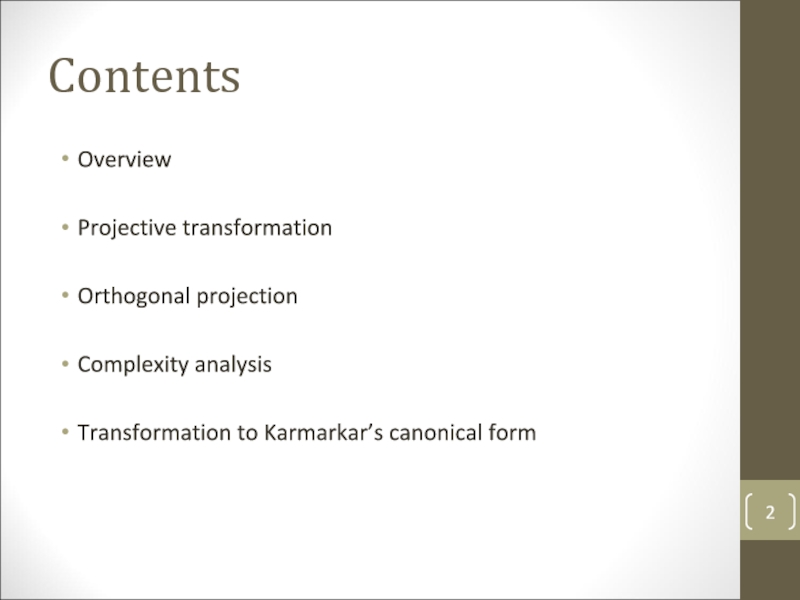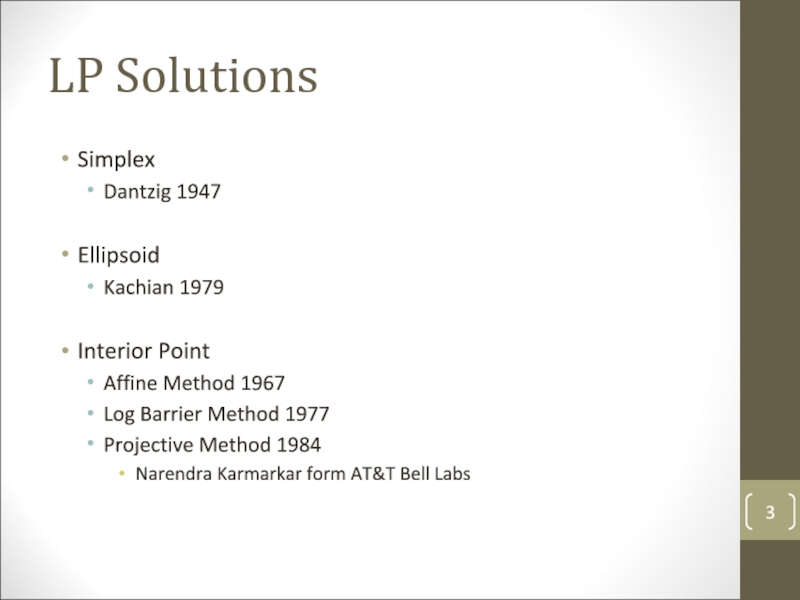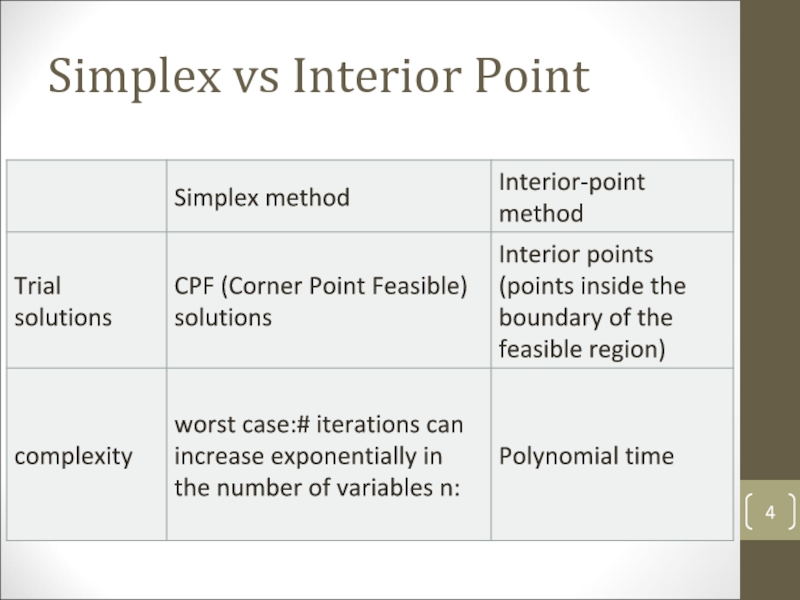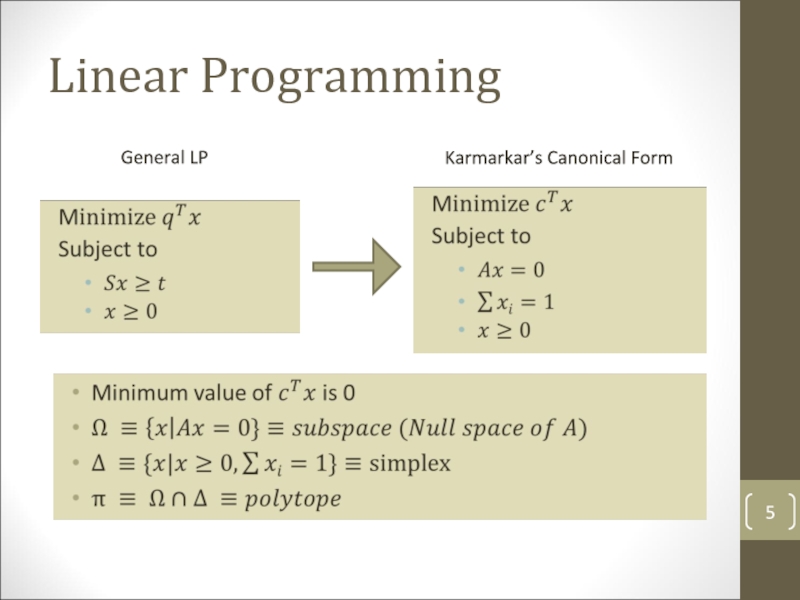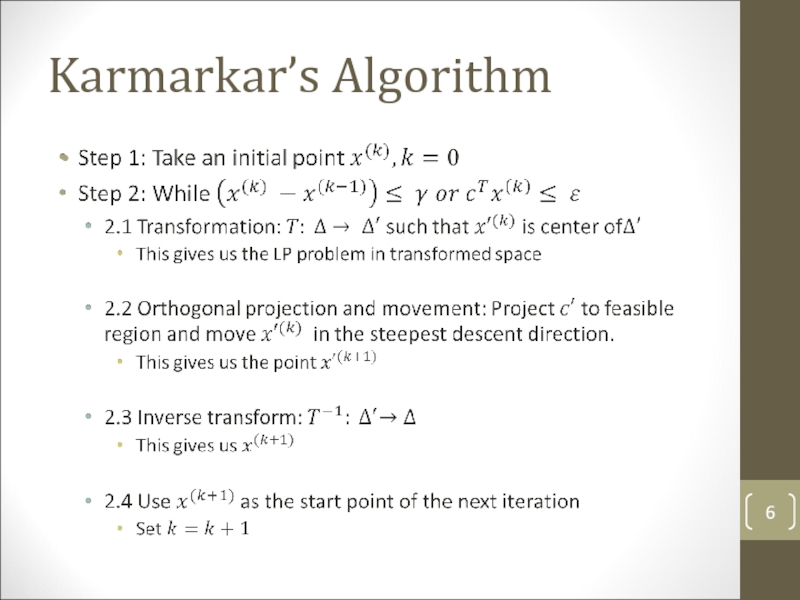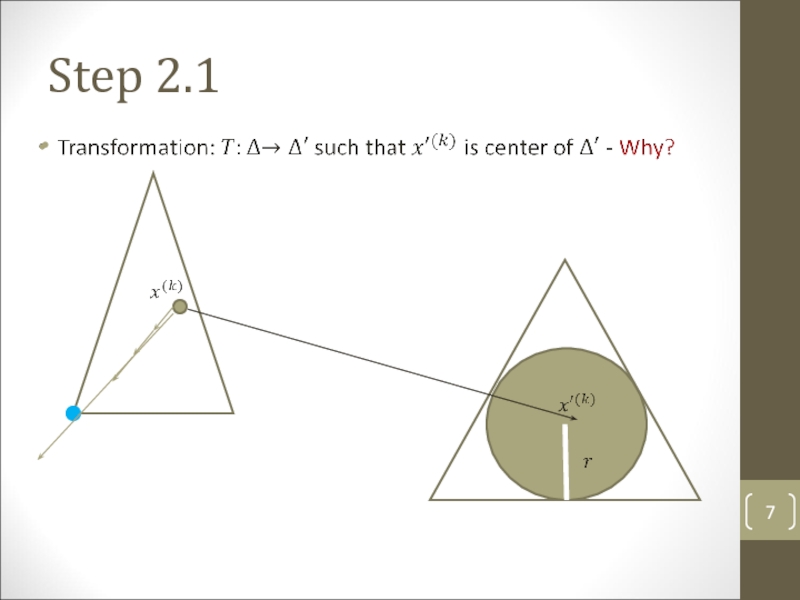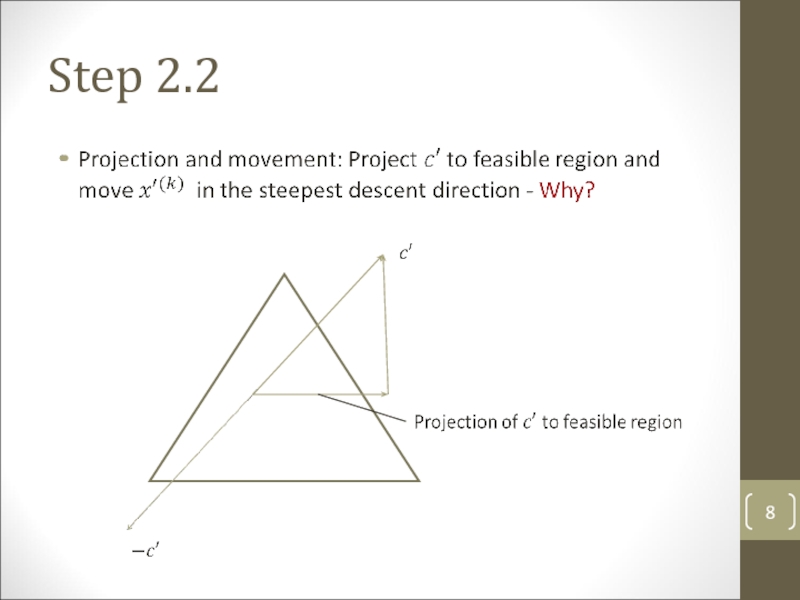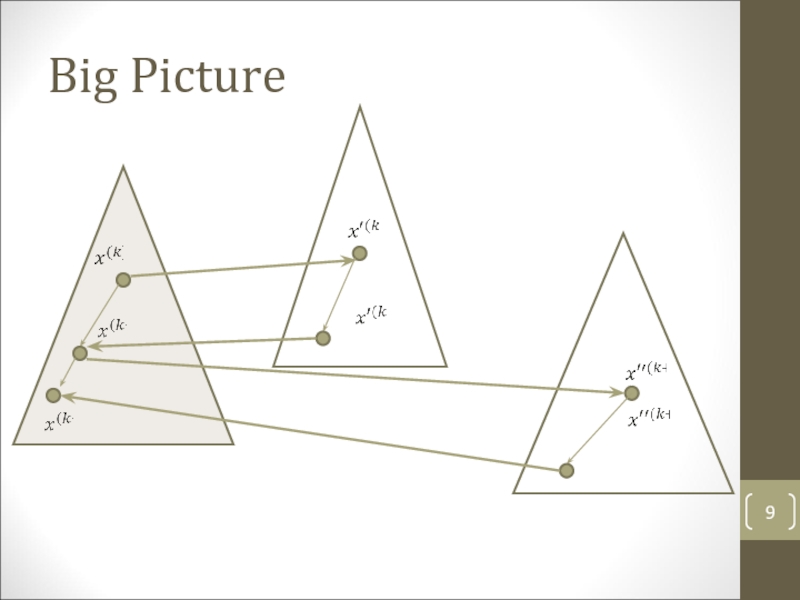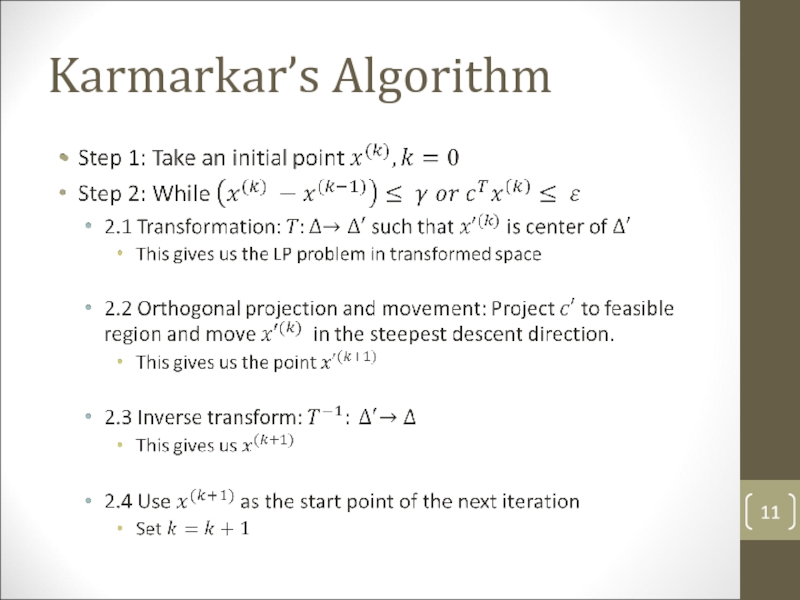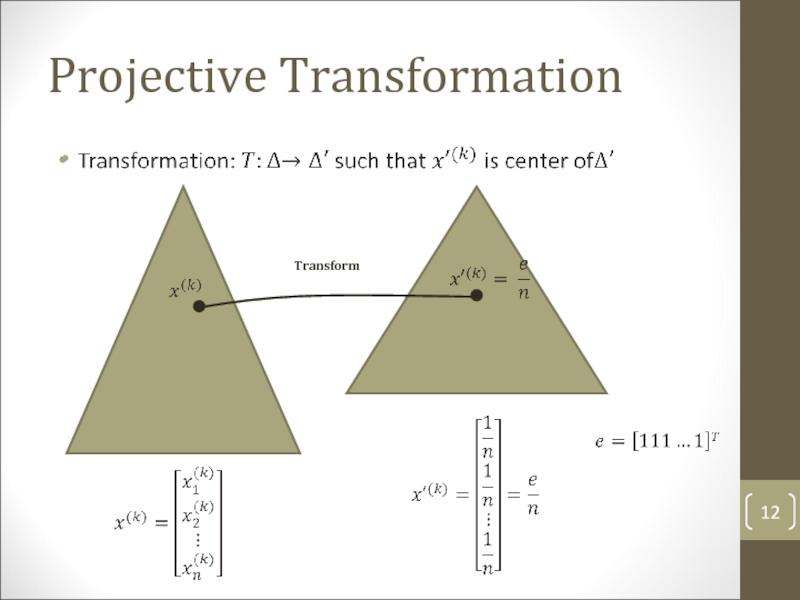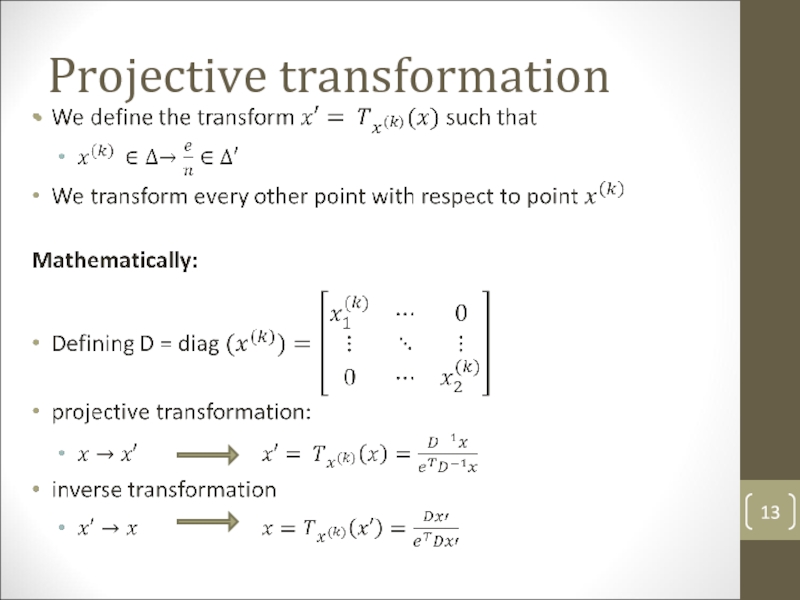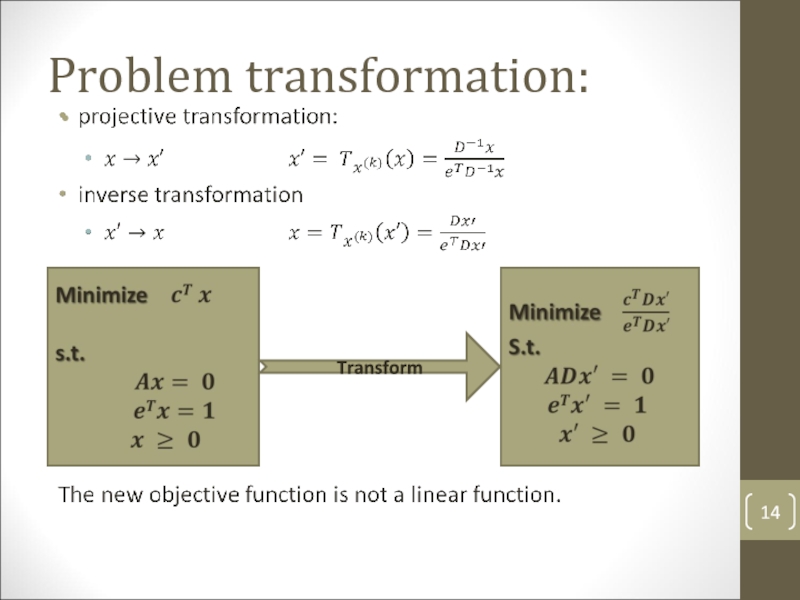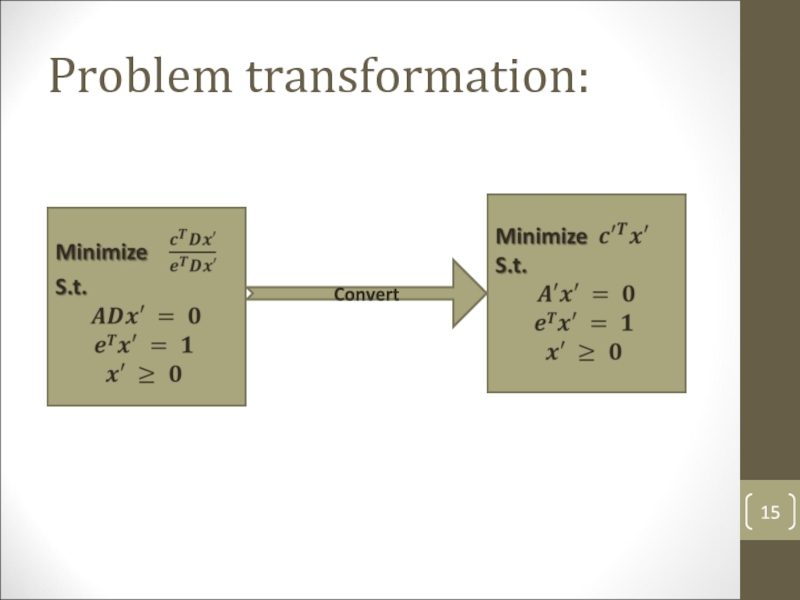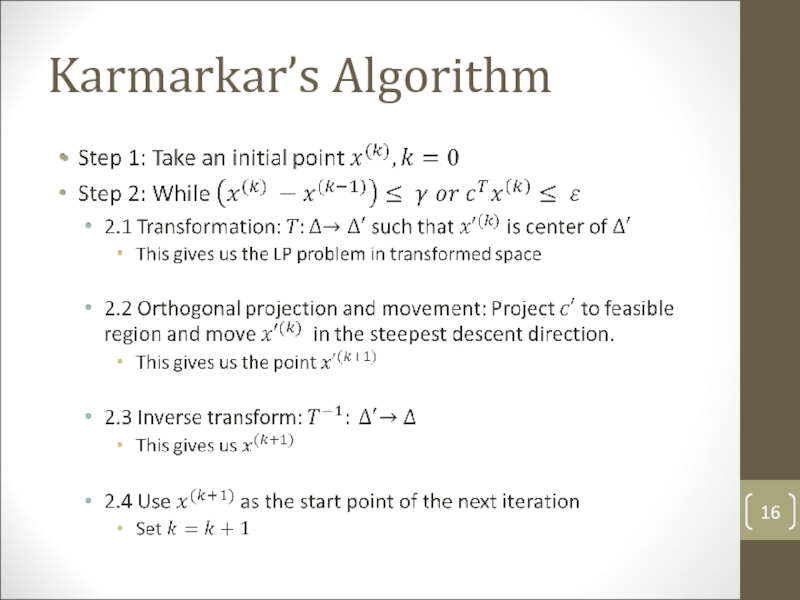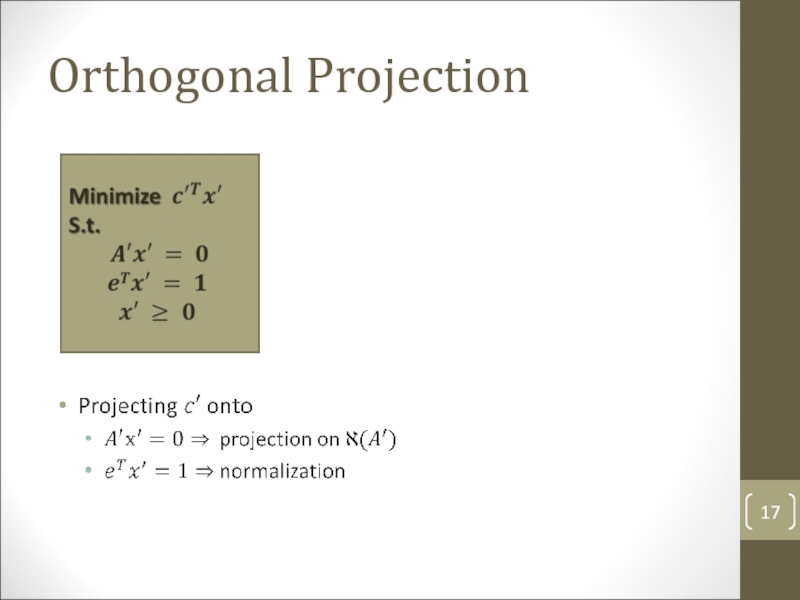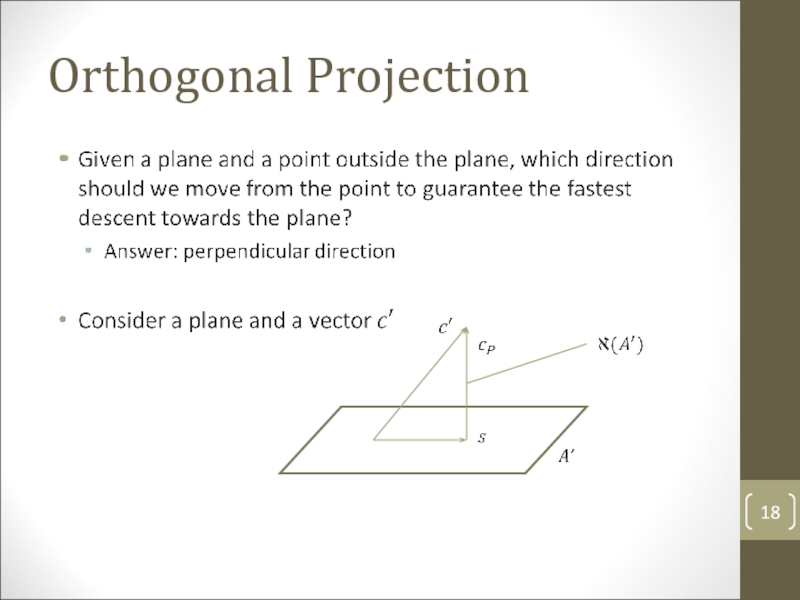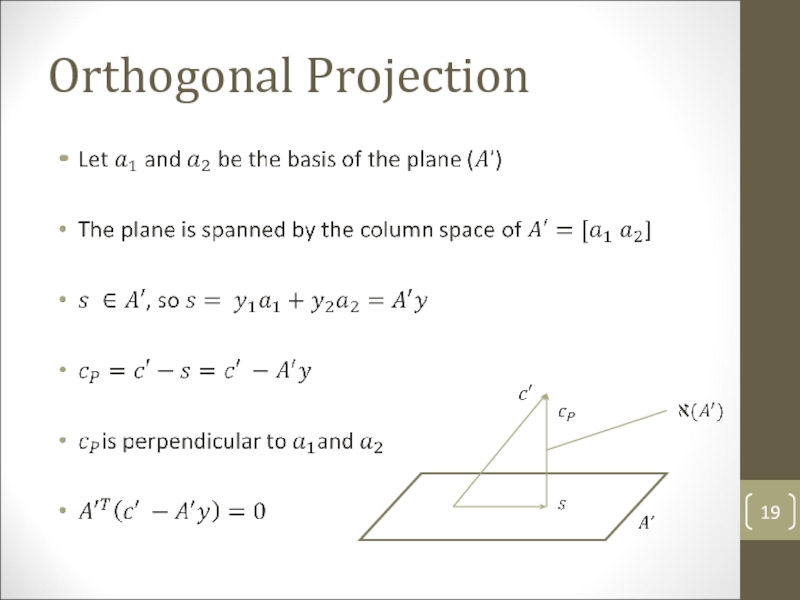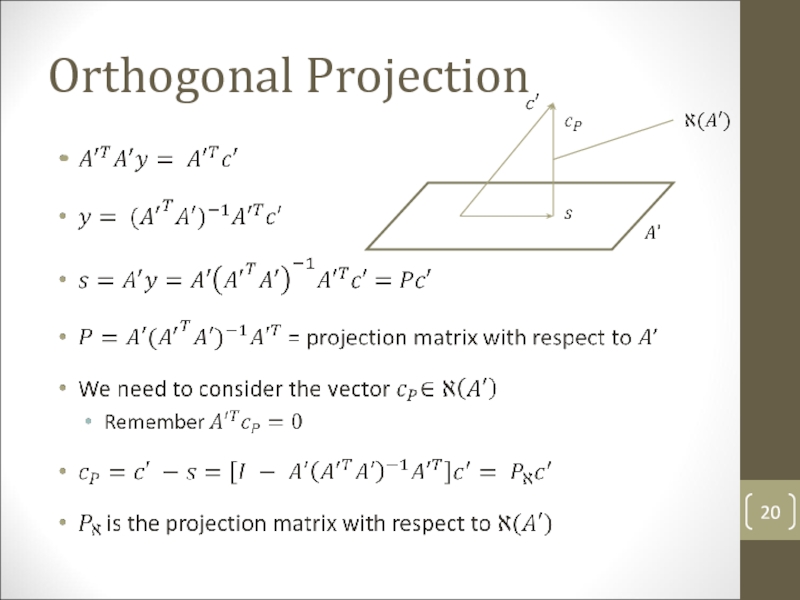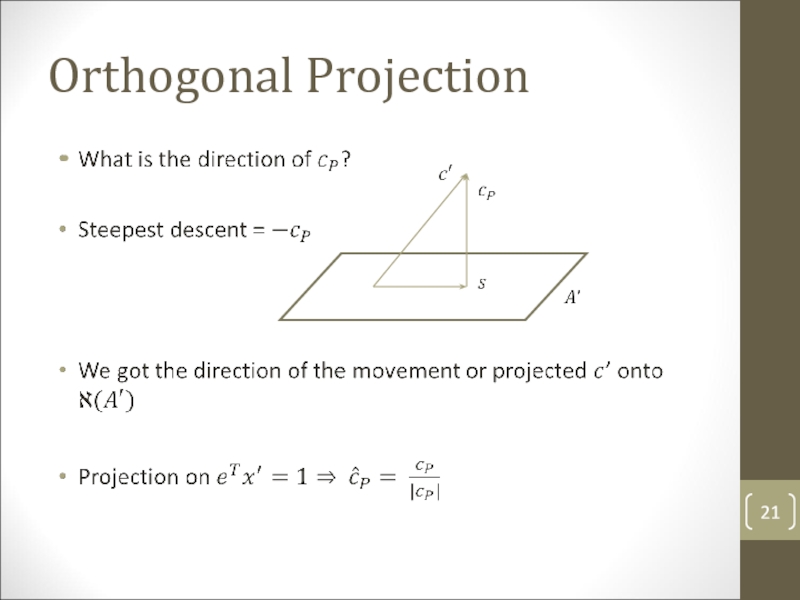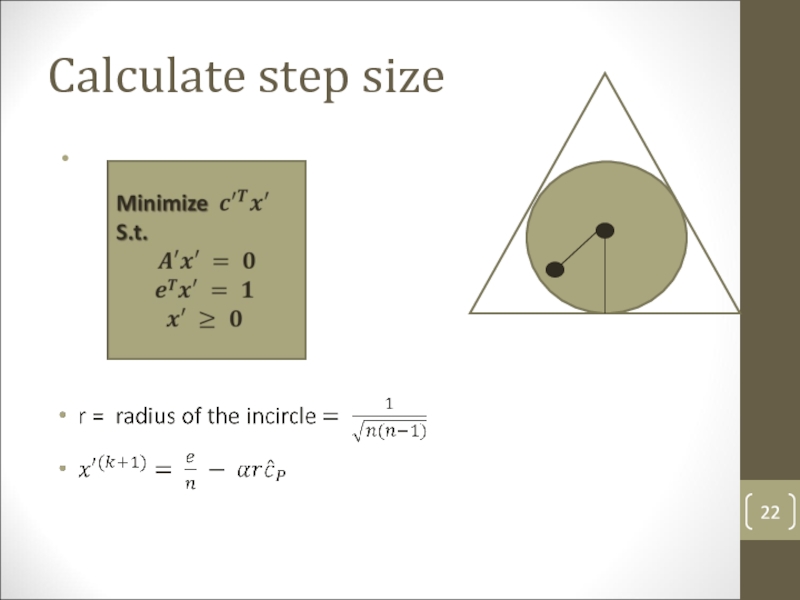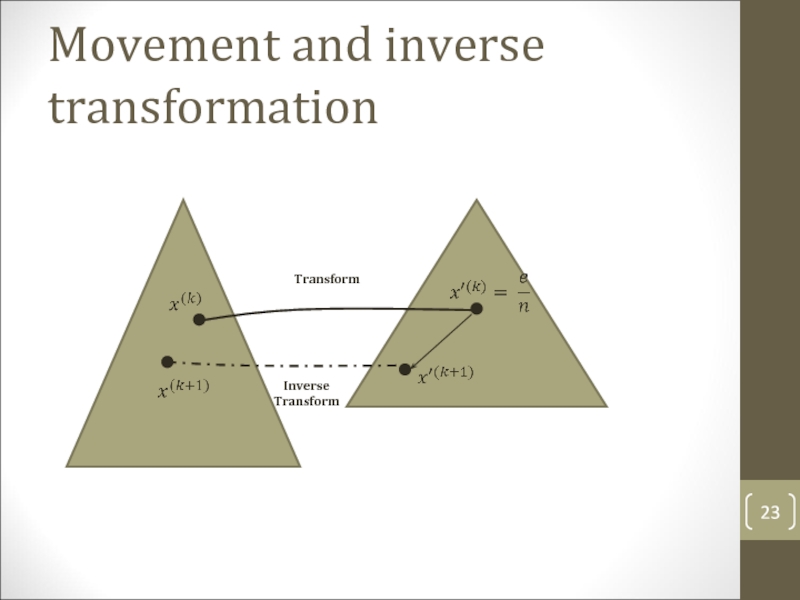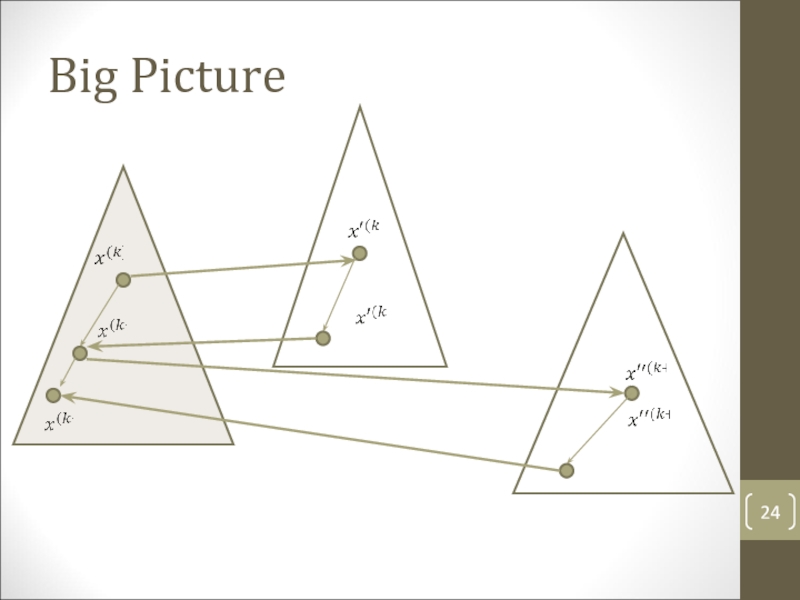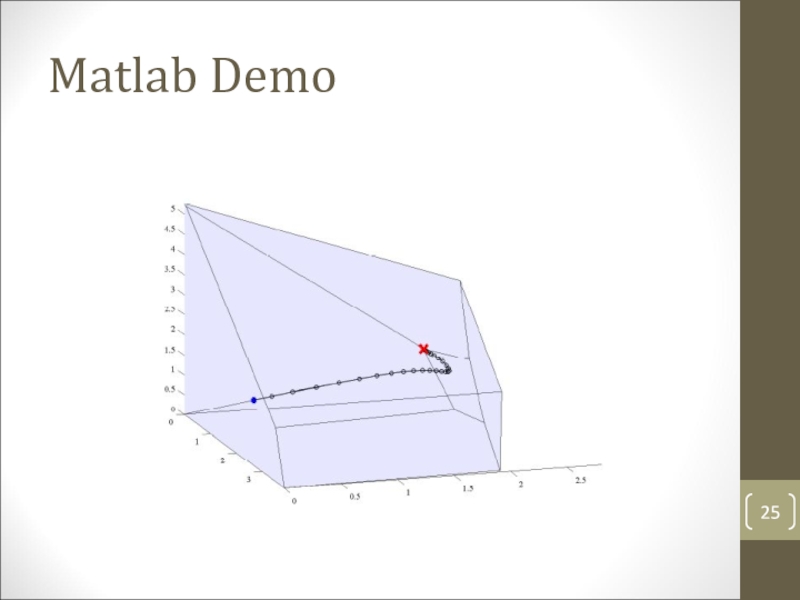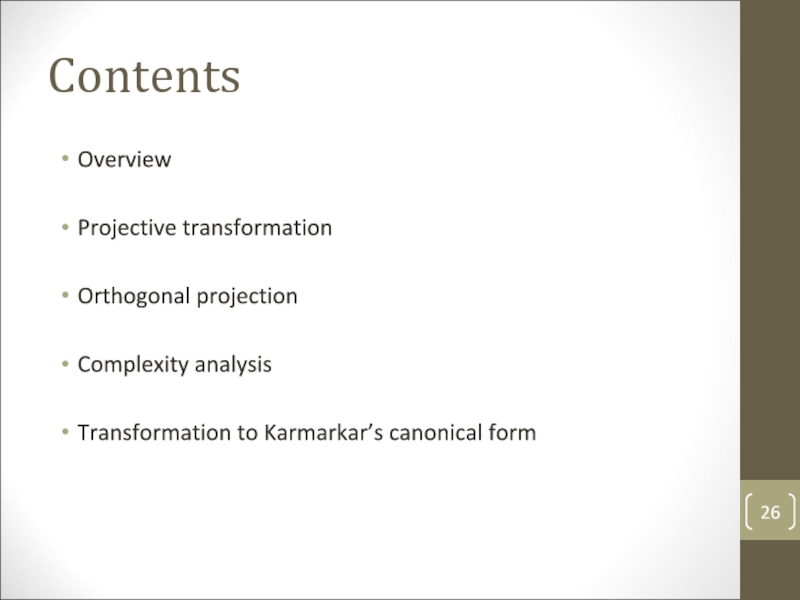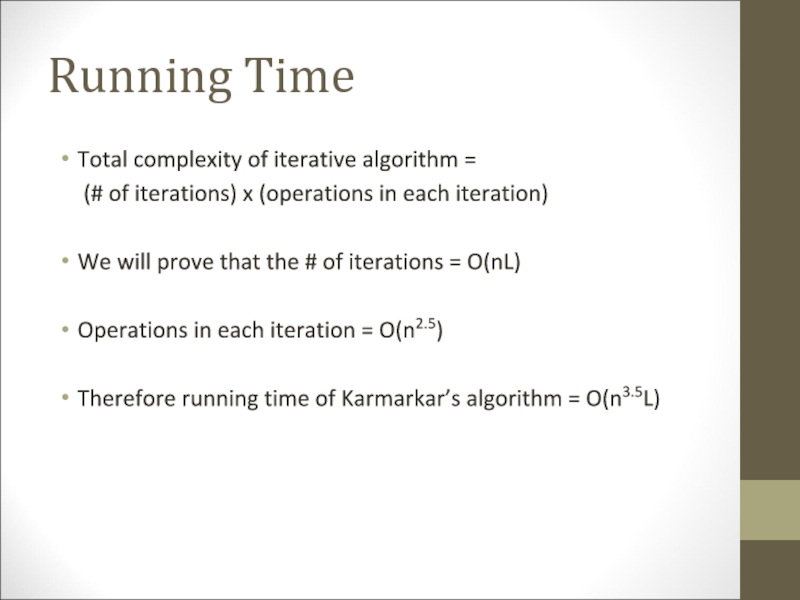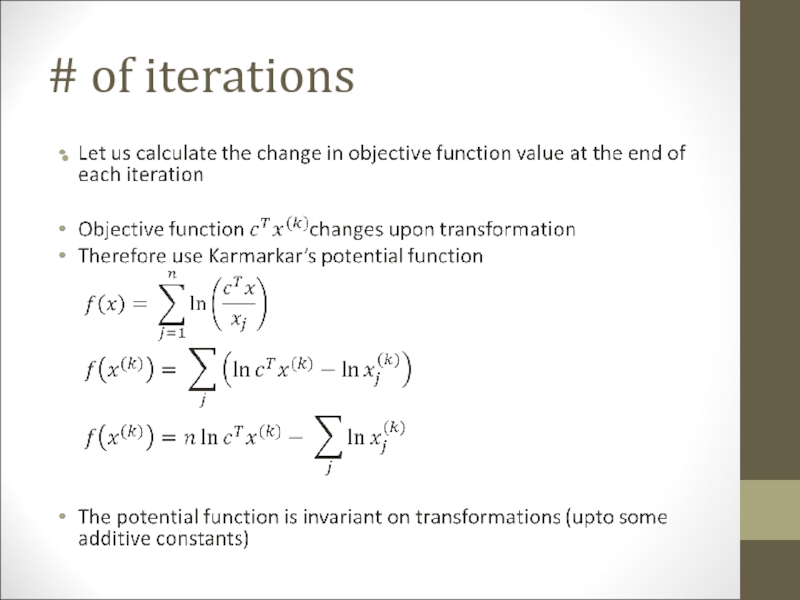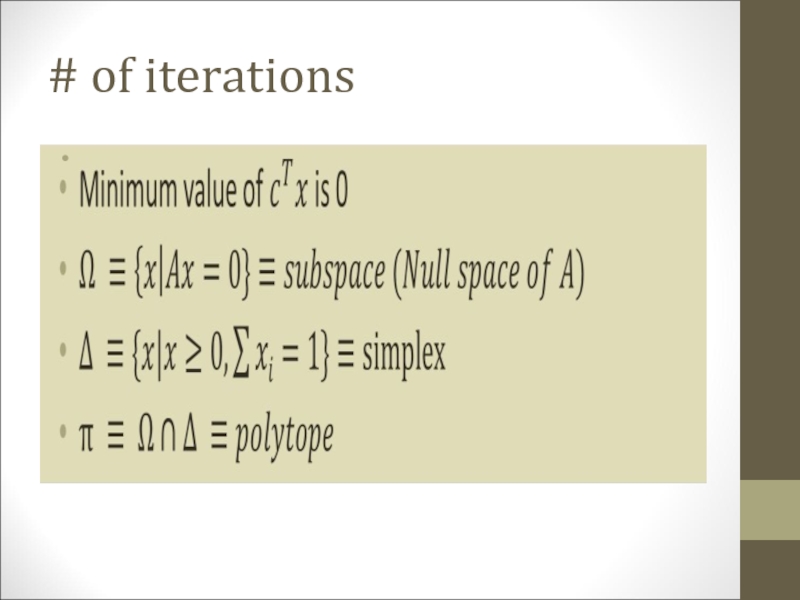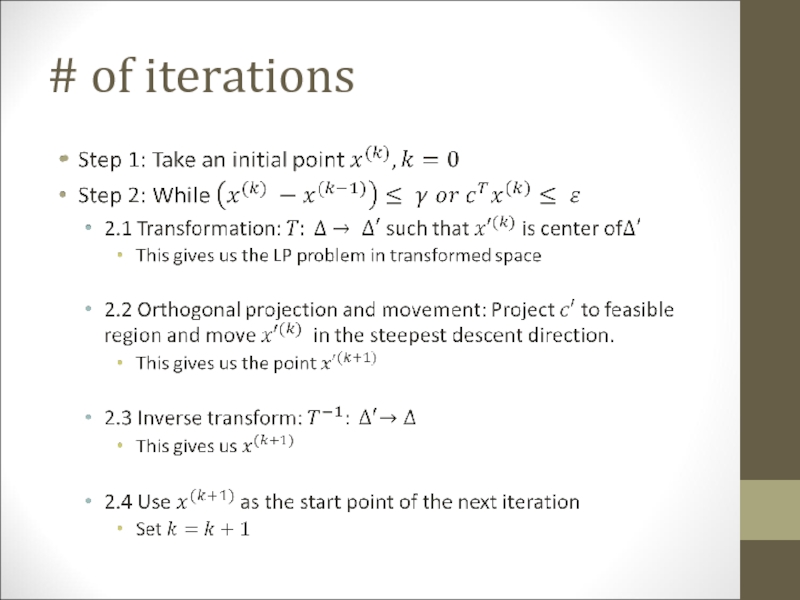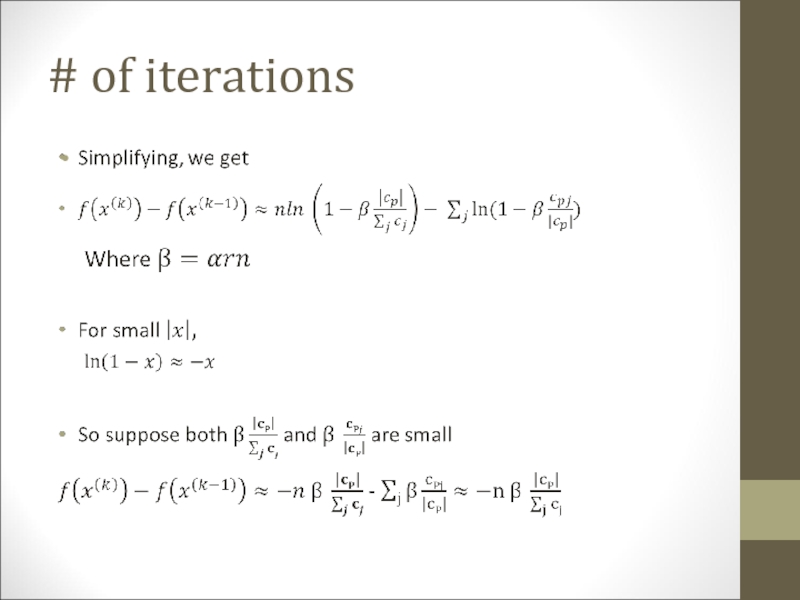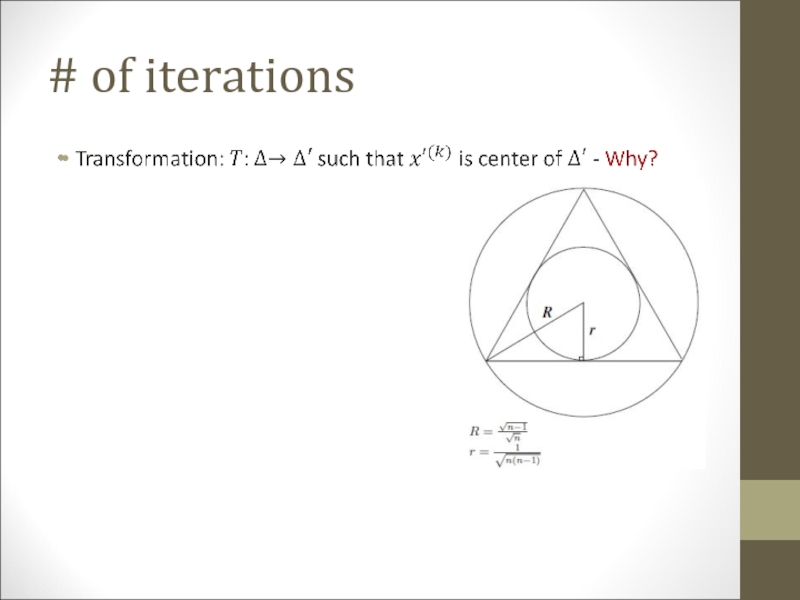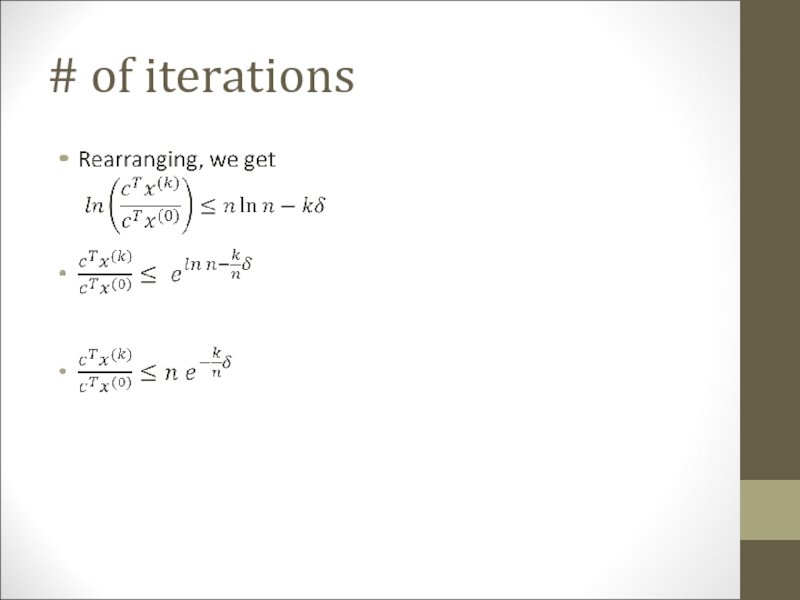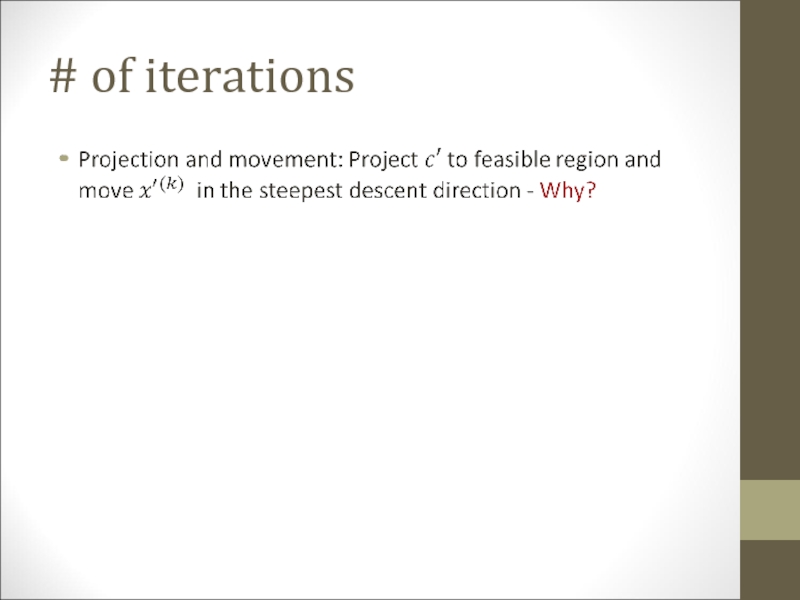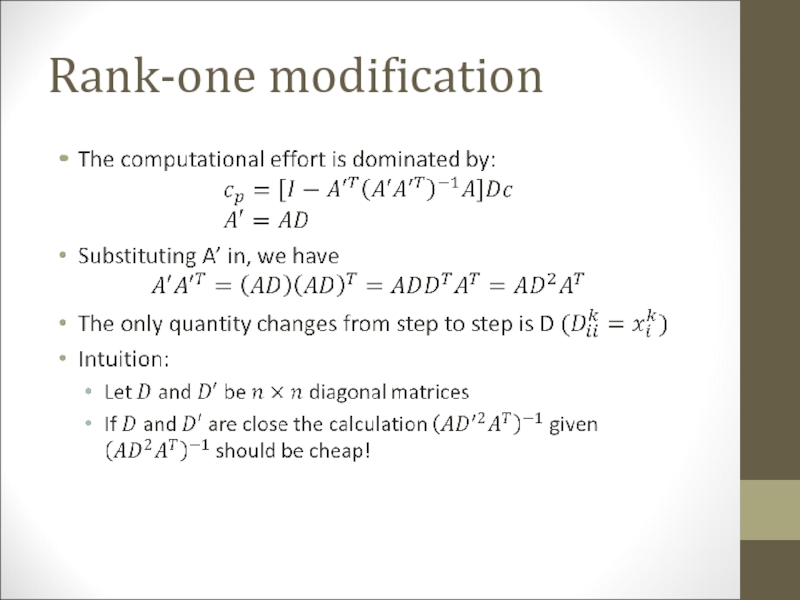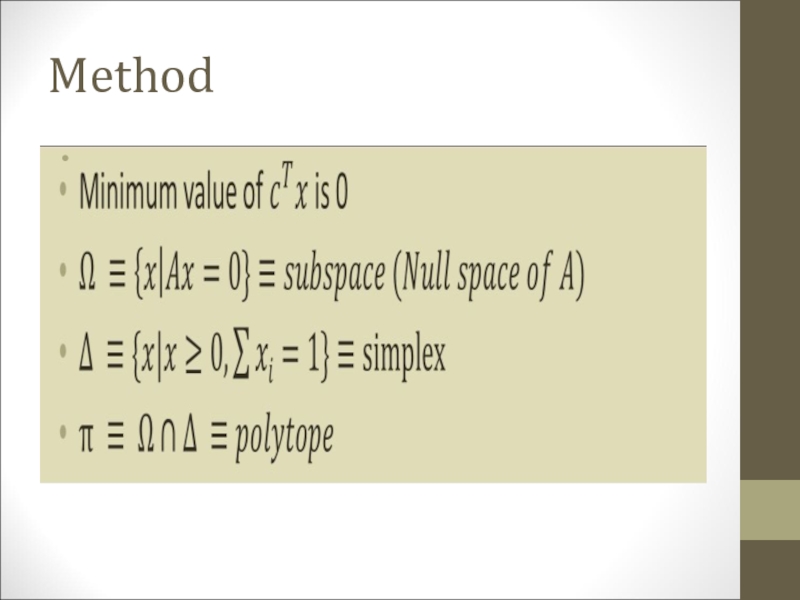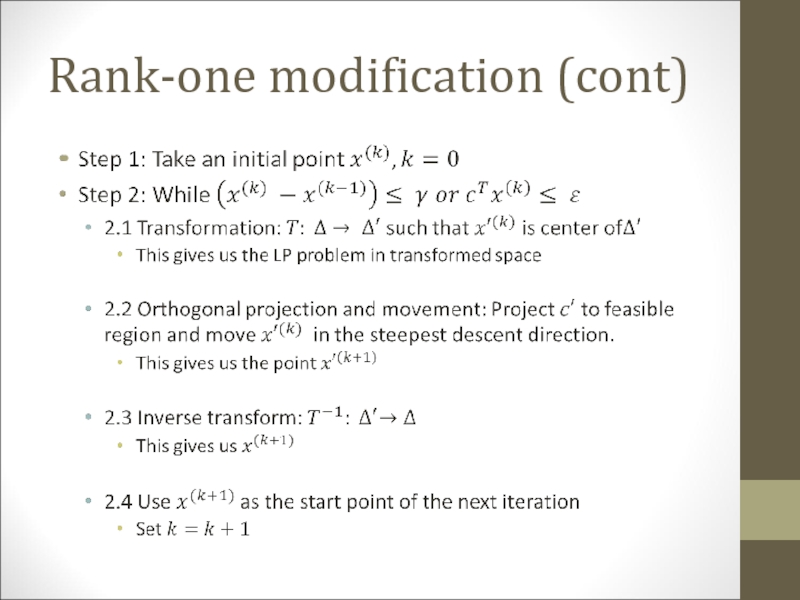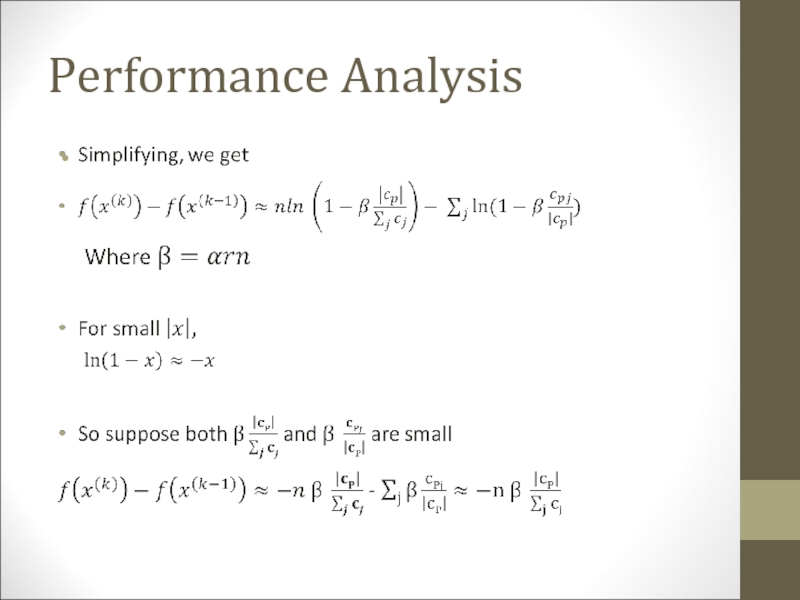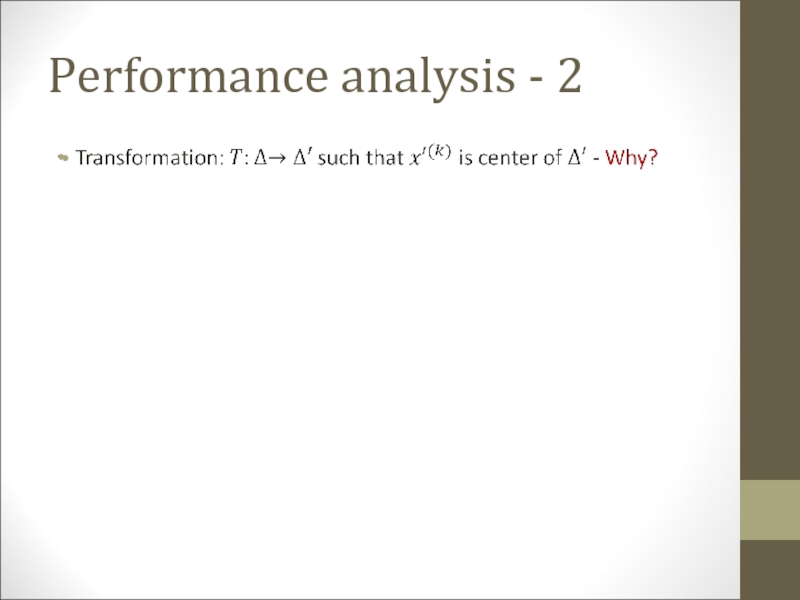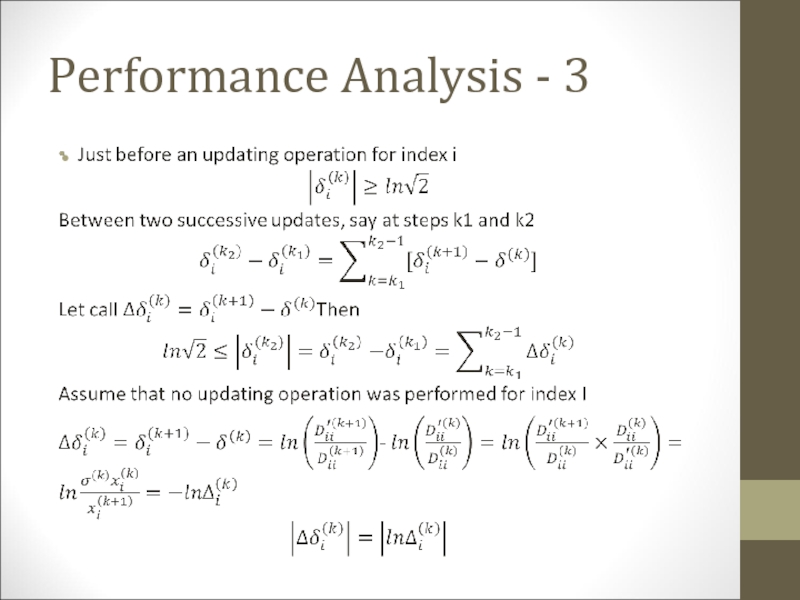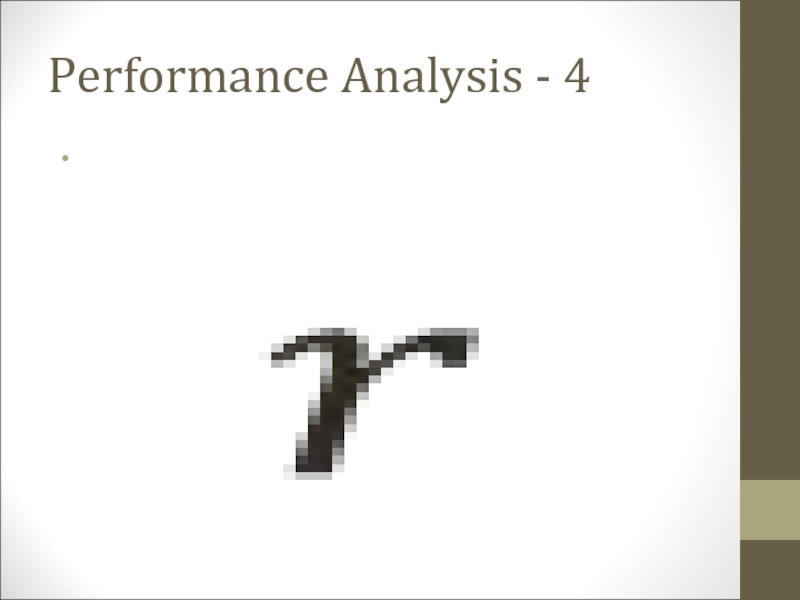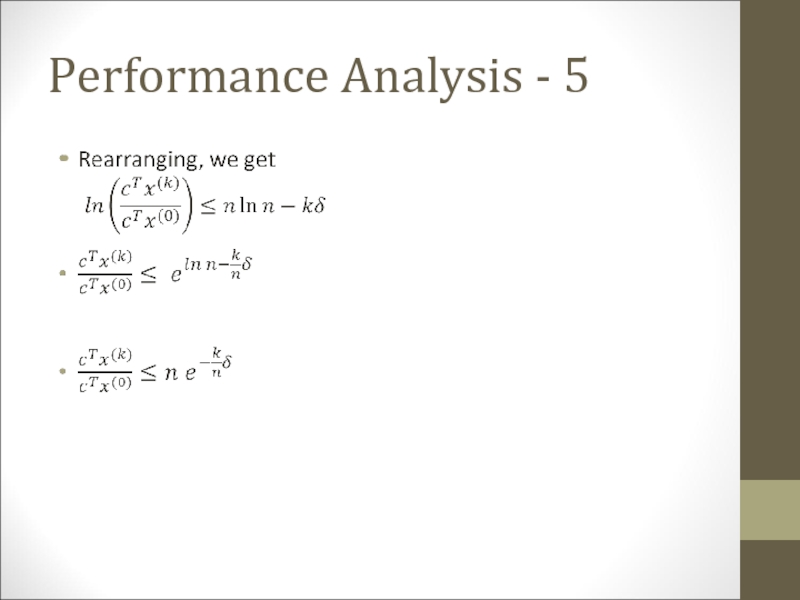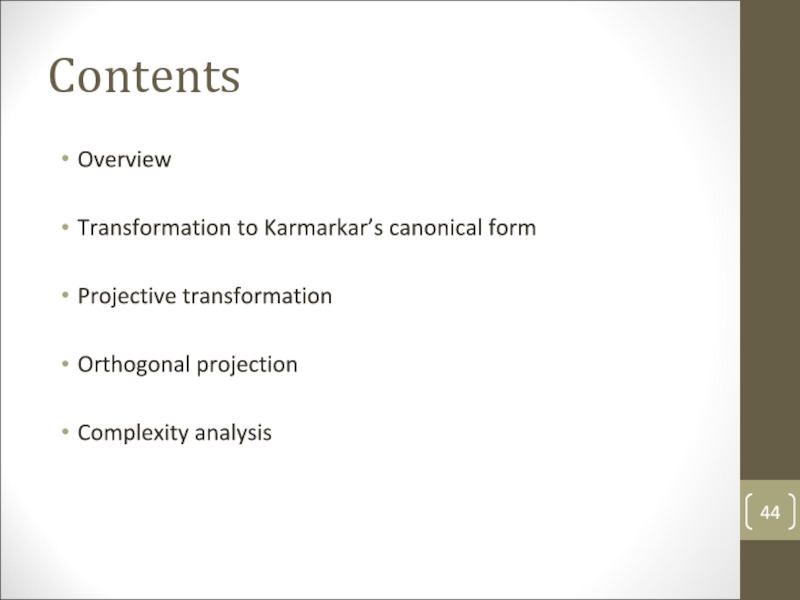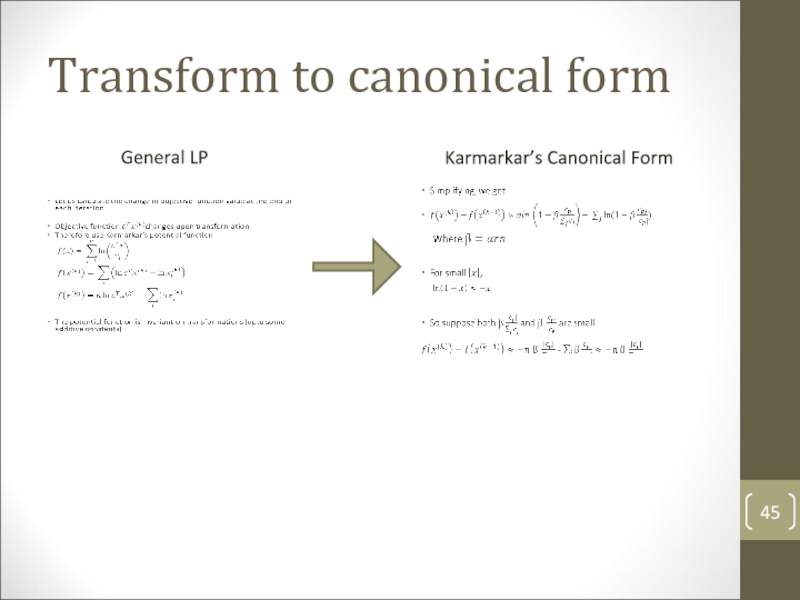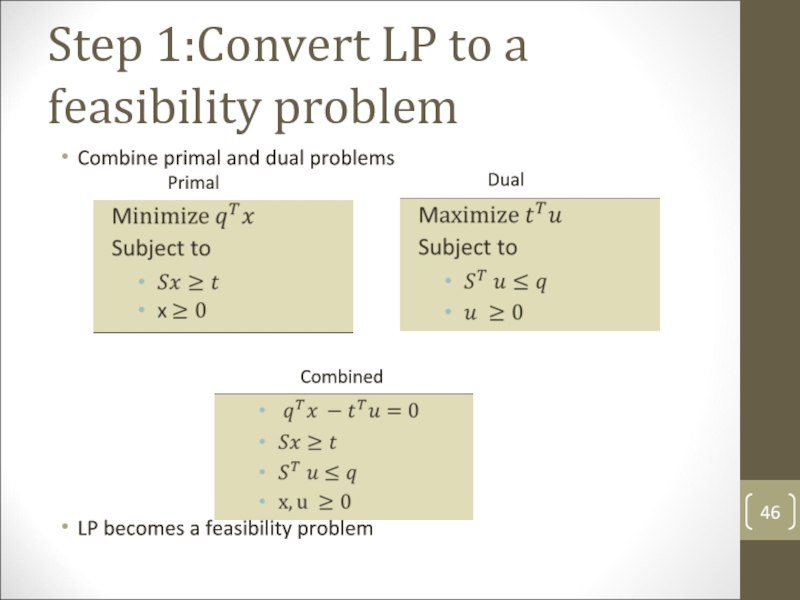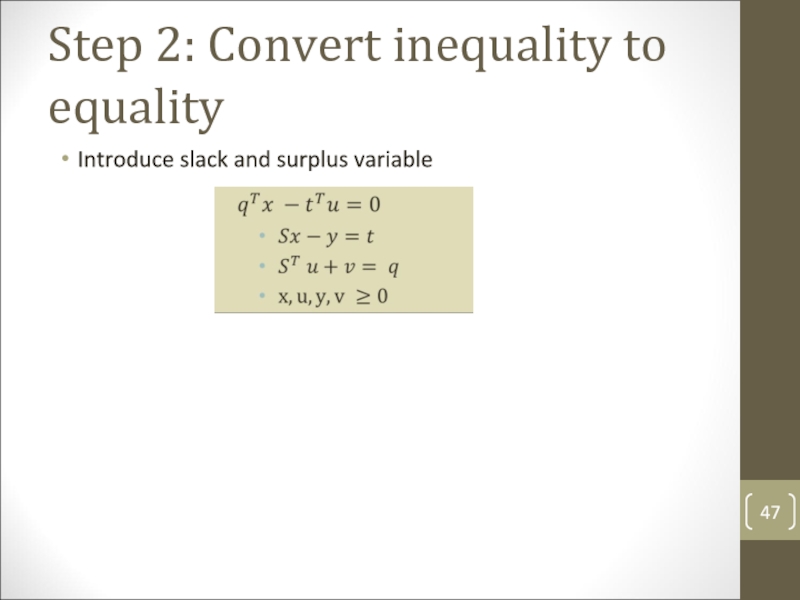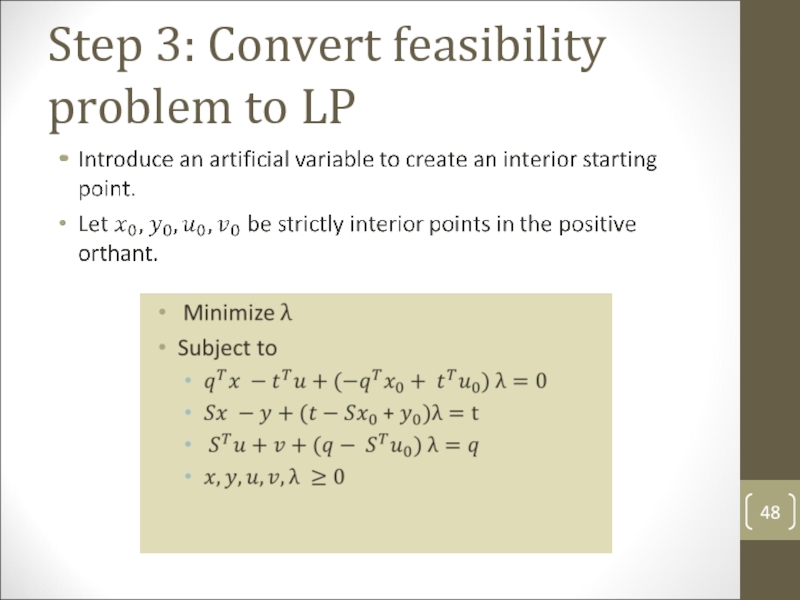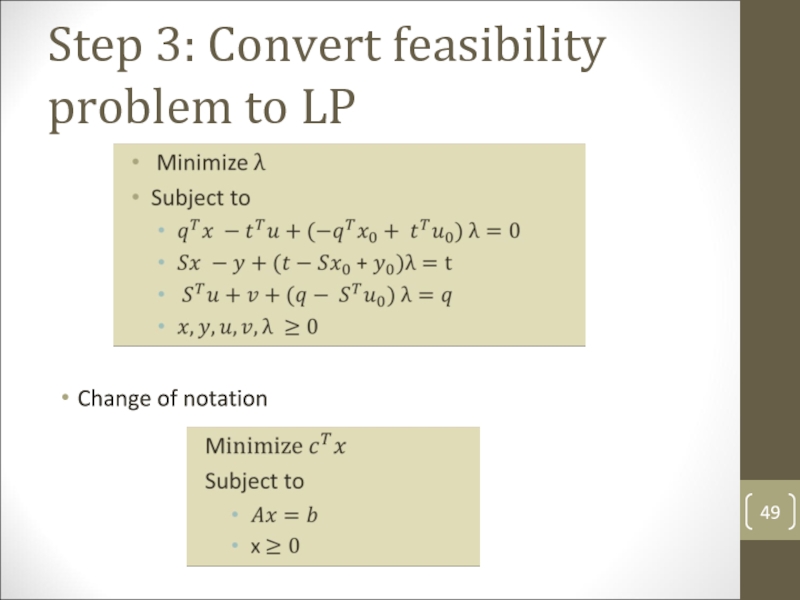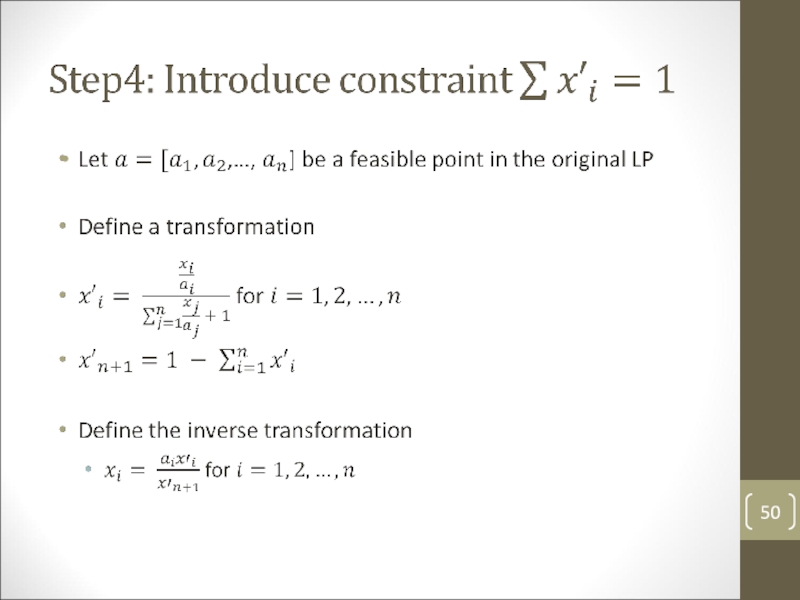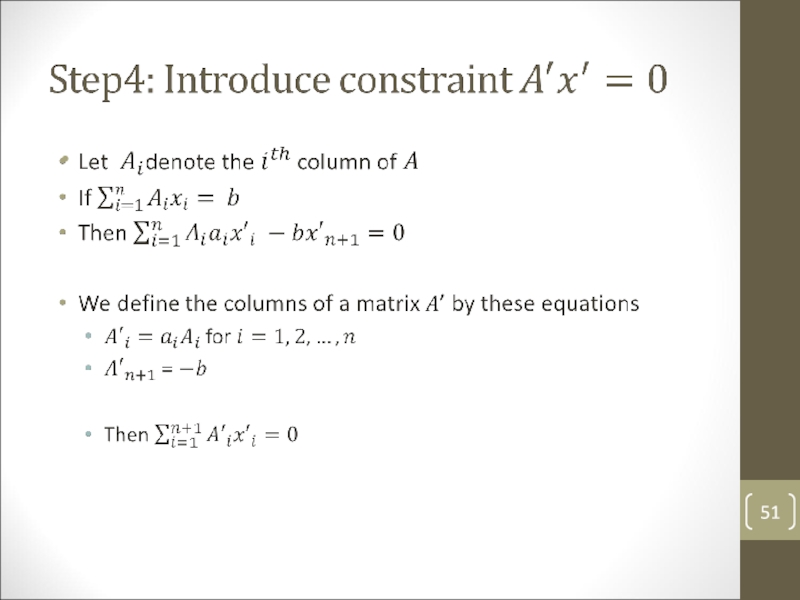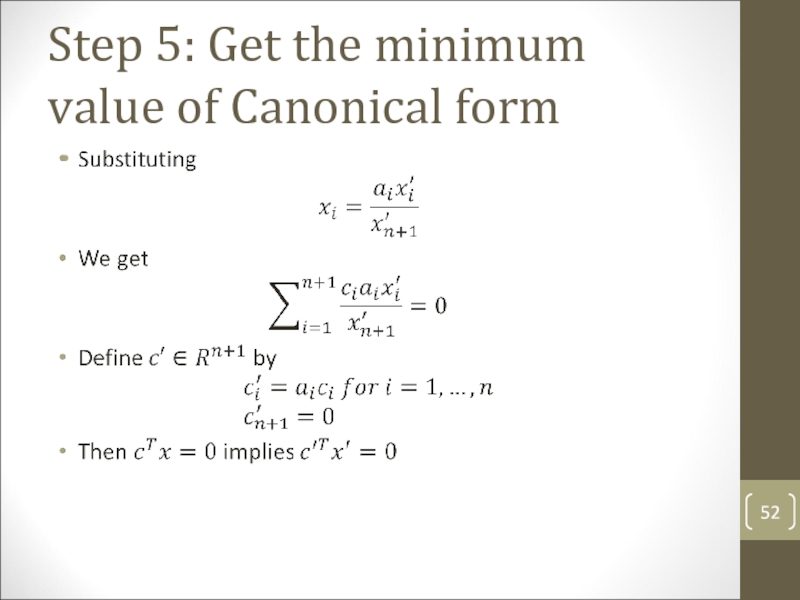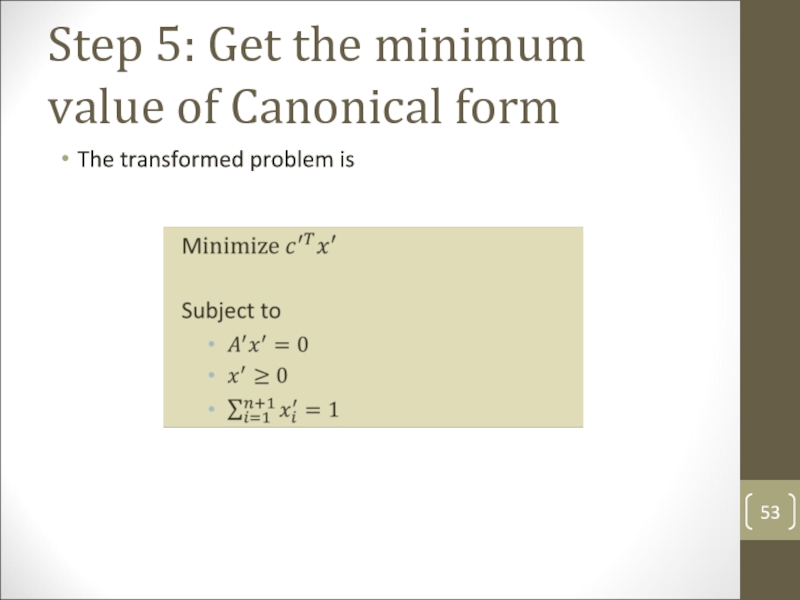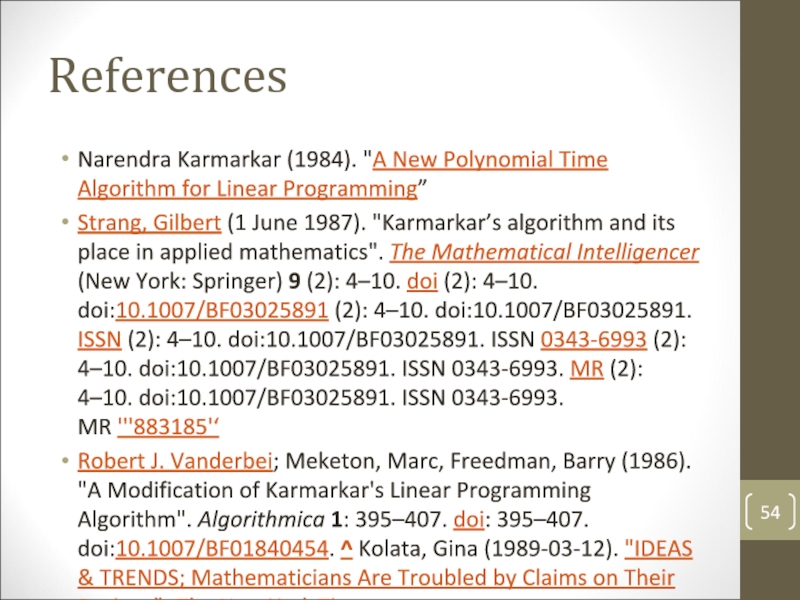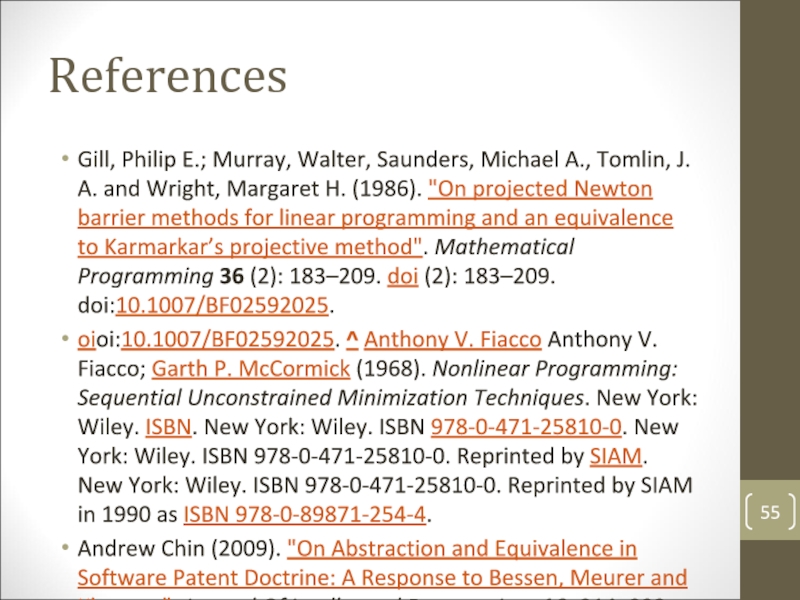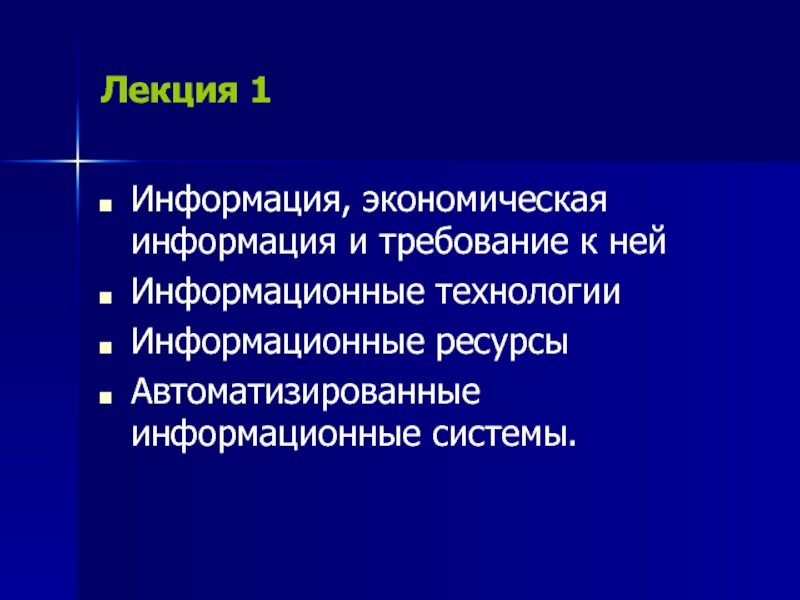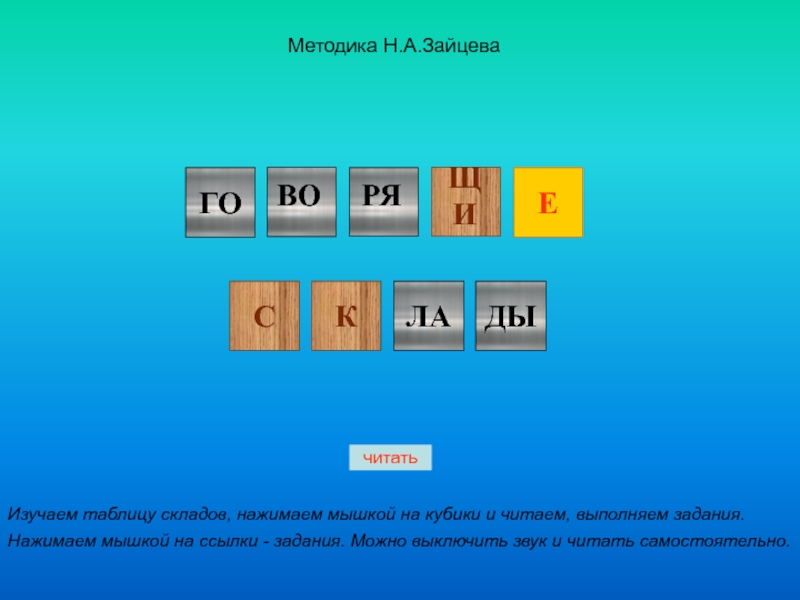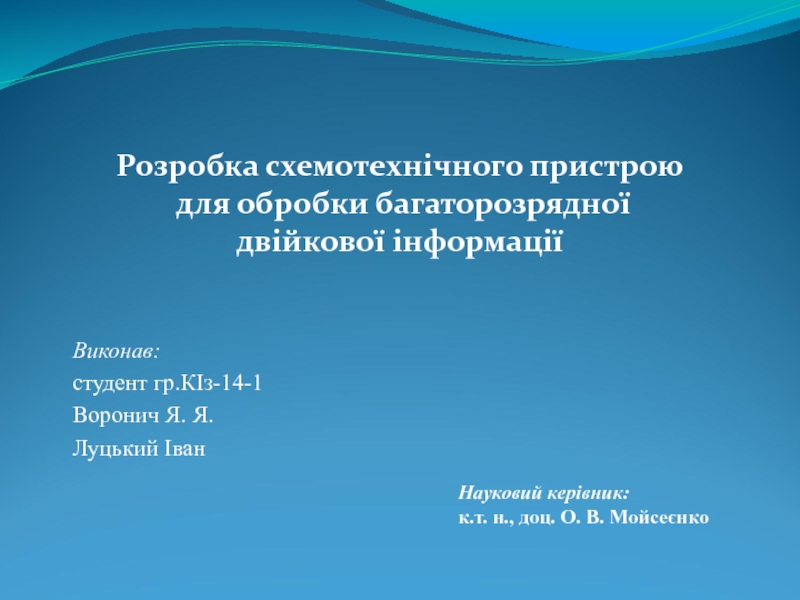Tuan Anh
- Главная
- Разное
- Дизайн
- Бизнес и предпринимательство
- Аналитика
- Образование
- Развлечения
- Красота и здоровье
- Финансы
- Государство
- Путешествия
- Спорт
- Недвижимость
- Армия
- Графика
- Культурология
- Еда и кулинария
- Лингвистика
- Английский язык
- Астрономия
- Алгебра
- Биология
- География
- Детские презентации
- Информатика
- История
- Литература
- Маркетинг
- Математика
- Медицина
- Менеджмент
- Музыка
- МХК
- Немецкий язык
- ОБЖ
- Обществознание
- Окружающий мир
- Педагогика
- Русский язык
- Технология
- Физика
- Философия
- Химия
- Шаблоны, картинки для презентаций
- Экология
- Экономика
- Юриспруденция
Karmarkar Algorithm презентация
Содержание
- 1. Karmarkar Algorithm
- 2. Contents Overview Projective transformation Orthogonal
- 3. LP Solutions Simplex Dantzig 1947 Ellipsoid
- 4. Simplex vs Interior Point
- 5. Linear Programming Karmarkar’s Canonical Form General LP
- 6. Karmarkar’s Algorithm
- 7. Step 2.1
- 8. Step 2.2
- 9. Big Picture
- 10. Contents Overview Transformation to Karmarkar’s canonical
- 11. Karmarkar’s Algorithm
- 12. Projective Transformation Transform
- 13. Projective transformation
- 14. Problem transformation: Transform
- 15. Problem transformation: Convert
- 16. Karmarkar’s Algorithm
- 17. Orthogonal Projection
- 18. Orthogonal Projection
- 19. Orthogonal Projection
- 20. Orthogonal Projection
- 21. Orthogonal Projection
- 22. Calculate step size
- 23. Movement and inverse transformation
- 24. Big Picture
- 25. Matlab Demo
- 26. Contents Overview Projective transformation Orthogonal
- 27. Running Time Total complexity of iterative algorithm
- 28. # of iterations
- 29. # of iterations
- 30. # of iterations
- 31. # of iterations
- 32. # of iterations
- 33. # of iterations
- 34. # of iterations
- 35. # of iterations
- 36. Rank-one modification
- 37. Method
- 38. Rank-one modification (cont)
- 39. Performance Analysis
- 40. Performance analysis - 2
- 41. Performance Analysis - 3
- 42. Performance Analysis - 4
- 43. Performance Analysis - 5
- 44. Contents Overview Transformation to Karmarkar’s canonical
- 45. Transform to canonical form
- 46. Step 1:Convert LP to a feasibility problem
- 47. Step 2: Convert inequality to equality Introduce slack and surplus variable
- 48. Step 3: Convert feasibility problem to LP
- 49. Step 3: Convert feasibility problem to LP
- 50.
- 51.
- 52. Step 5: Get the minimum value of Canonical form
- 53. Step 5: Get the minimum value of
- 54. References Narendra Karmarkar (1984). "A New Polynomial
- 55. References Gill, Philip E.; Murray, Walter, Saunders,
- 56. Q&A
Слайд 2Contents
Overview
Projective transformation
Orthogonal projection
Complexity analysis
Transformation to Karmarkar’s canonical form
Слайд 3LP Solutions
Simplex
Dantzig 1947
Ellipsoid
Kachian 1979
Interior Point
Affine Method 1967
Log Barrier Method 1977
Projective Method
1984
Narendra Karmarkar form AT&T Bell Labs
Narendra Karmarkar form AT&T Bell Labs
Слайд 10Contents
Overview
Transformation to Karmarkar’s canonical form
Projective transformation
Orthogonal projection
Complexity analysis
Слайд 26Contents
Overview
Projective transformation
Orthogonal projection
Complexity analysis
Transformation to Karmarkar’s canonical form
Слайд 27Running Time
Total complexity of iterative algorithm =
(# of iterations) x
(operations in each iteration)
We will prove that the # of iterations = O(nL)
Operations in each iteration = O(n2.5)
Therefore running time of Karmarkar’s algorithm = O(n3.5L)
We will prove that the # of iterations = O(nL)
Operations in each iteration = O(n2.5)
Therefore running time of Karmarkar’s algorithm = O(n3.5L)
Слайд 44Contents
Overview
Transformation to Karmarkar’s canonical form
Projective transformation
Orthogonal projection
Complexity analysis
Слайд 46Step 1:Convert LP to a feasibility problem
Combine primal and dual problems
LP
becomes a feasibility problem
Primal
Dual
Combined
Слайд 54References
Narendra Karmarkar (1984). "A New Polynomial Time Algorithm for Linear Programming”
Strang,
Gilbert (1 June 1987). "Karmarkar’s algorithm and its place in applied mathematics". The Mathematical Intelligencer (New York: Springer) 9 (2): 4–10. doi (2): 4–10. doi:10.1007/BF03025891 (2): 4–10. doi:10.1007/BF03025891. ISSN (2): 4–10. doi:10.1007/BF03025891. ISSN 0343-6993 (2): 4–10. doi:10.1007/BF03025891. ISSN 0343-6993. MR (2): 4–10. doi:10.1007/BF03025891. ISSN 0343-6993. MR '''883185'‘
Robert J. Vanderbei; Meketon, Marc, Freedman, Barry (1986). "A Modification of Karmarkar's Linear Programming Algorithm". Algorithmica 1: 395–407. doi: 395–407. doi:10.1007/BF01840454. ^ Kolata, Gina (1989-03-12). "IDEAS & TRENDS; Mathematicians Are Troubled by Claims on Their Recipes". The New York Times.
Robert J. Vanderbei; Meketon, Marc, Freedman, Barry (1986). "A Modification of Karmarkar's Linear Programming Algorithm". Algorithmica 1: 395–407. doi: 395–407. doi:10.1007/BF01840454. ^ Kolata, Gina (1989-03-12). "IDEAS & TRENDS; Mathematicians Are Troubled by Claims on Their Recipes". The New York Times.
Слайд 55References
Gill, Philip E.; Murray, Walter, Saunders, Michael A., Tomlin, J. A.
and Wright, Margaret H. (1986). "On projected Newton barrier methods for linear programming and an equivalence to Karmarkar’s projective method". Mathematical Programming 36 (2): 183–209. doi (2): 183–209. doi:10.1007/BF02592025.
oioi:10.1007/BF02592025. ^ Anthony V. Fiacco Anthony V. Fiacco; Garth P. McCormick (1968). Nonlinear Programming: Sequential Unconstrained Minimization Techniques. New York: Wiley. ISBN. New York: Wiley. ISBN 978-0-471-25810-0. New York: Wiley. ISBN 978-0-471-25810-0. Reprinted by SIAM. New York: Wiley. ISBN 978-0-471-25810-0. Reprinted by SIAM in 1990 as ISBN 978-0-89871-254-4.
Andrew Chin (2009). "On Abstraction and Equivalence in Software Patent Doctrine: A Response to Bessen, Meurer and Klemens". Journal Of Intellectual Property Law 16: 214–223.
oioi:10.1007/BF02592025. ^ Anthony V. Fiacco Anthony V. Fiacco; Garth P. McCormick (1968). Nonlinear Programming: Sequential Unconstrained Minimization Techniques. New York: Wiley. ISBN. New York: Wiley. ISBN 978-0-471-25810-0. New York: Wiley. ISBN 978-0-471-25810-0. Reprinted by SIAM. New York: Wiley. ISBN 978-0-471-25810-0. Reprinted by SIAM in 1990 as ISBN 978-0-89871-254-4.
Andrew Chin (2009). "On Abstraction and Equivalence in Software Patent Doctrine: A Response to Bessen, Meurer and Klemens". Journal Of Intellectual Property Law 16: 214–223.

